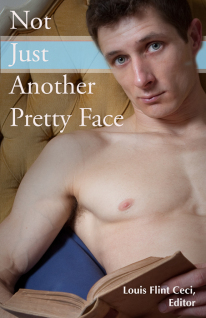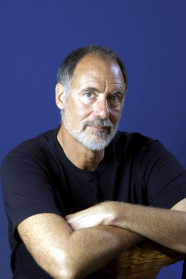Sunday Shorts – “Not Just Another Pretty Face” Q&A with Louis Flint Ceci
 Today I’ve got Louis Flint Ceci with me, and I’m sharing a chat we had about an upcoming collection that breaks the usual formats in a couple of ways. Louis Flint Ceci is another editor and author I met through the Saints and Sinners Literary Festival (is there no end to the awesome folk that attend?) and when I heard about the collection in question, Not Just Another Pretty Face, I was definitely intrigued. Sparking content with pictures wasn’t something I’d ever tried before, but when I saw the photos, one caught my eye immediately, and I couldn’t wait to give it a shot.
Today I’ve got Louis Flint Ceci with me, and I’m sharing a chat we had about an upcoming collection that breaks the usual formats in a couple of ways. Louis Flint Ceci is another editor and author I met through the Saints and Sinners Literary Festival (is there no end to the awesome folk that attend?) and when I heard about the collection in question, Not Just Another Pretty Face, I was definitely intrigued. Sparking content with pictures wasn’t something I’d ever tried before, but when I saw the photos, one caught my eye immediately, and I couldn’t wait to give it a shot.
Twenty-three photos of male go-go dancers become the basis for stories, poems, essays, and drama by twenty-seven authors, revealing unexpected mysteries, romance, fantasy, and humor. Contributors include 2015 Sue Kaufman Prize winner Michael Carroll, 2013 Lambda Mid-Career author Trebor Healey, and Lammy winners Jeff Mann, David Pratt, and Jim Provenzano.
NB: Not Just Another Pretty Face is fairly unique to my reading (and writing) experience in that the works are all inspired from the visual cues of the photographs.
LFC: I was delighted to learn from one of the contributors that there’s actually a name for this kind of work: ekphrasis. Now there’s a word to send you scurrying to Google! It literally means, “to proclaim an object by name,” and is generally “a graphic, often dramatic, description of a visual work of art.” I have seen anthologies where illustrations were added after-the-fact, but I know of none where the anthology started with the art. I think we’re unique in that.
NB: It’s certainly one of the first I’m aware of. Also, it contains fiction, poetry, and essays, right?
LFC: And a one-act play. I’ve always liked anthologies that mix genres. It’s like examining a gem or mineral under different kinds of light. Two of my favorites are Queer Dharma: Voices of Gay Buddhism, which came out in 1998, and Queer and Catholic, which I got to contribute to in 2009.
NB: What was the birth of the idea for you to put together a collection like this?
LFC: It was when I saw a certain photograph by Tom Schmidt. I’ve long been a fan of Dot’s work. (Tom goes by “Dot” when talking about his photographs. It emphasizes the digital nature of his art.) He and I have collaborated before by staging certain visual elements of my novels to help me get the details right. Dot was showing me photographs of male go-go dancers and wondering how he could make a coherent collection of them. Then I saw one that took my breath away. It was haunting. “I could write a story about that,” I said. And that’s how the idea was born. The photo is in the book: it inspired Erik Schuckers’ short story and Alan Martinez’s poem.
NB: When I chose my photo, I immediately had a paranormal fiction in mind. Given the photograph cues and the minds of authors, I can only imagine the overall range of themes and genres explored. What are we in for?
LFC: I will not quote Forest Gump at this point, but prepare to be surprised. I got submissions I never expected. I mean, who has even heard of a hip-hop villanelle before?
NB: I certainly haven’t (he says, quickly looking up the word “villanelle”). Though that’s a great lead in to question from my discussion with Tom Cardamone I’ve been repeating with as many editors as I can. He brought up how in collections the author (or for an anthology like Not Just Another Pretty Face, the editor) has to select and order the stories, and how it’s such an important part of the process, but we rarely discuss that process. How did you approach selecting and ordering the poems, stories, play, and essays for the anthology?
LFC: As an editor, I wanted the collection to have breadth (that’s why I left it open to all genres) and yet coherence. I wanted each entry to stand on its own, and yet the whole to follow a kind of arc—not necessarily a narrative arc, but an aesthetic one. So I balanced emotionally dense entries with lighter fare, followed literary fiction with a romp in a genre. Sometimes the last verbal image in one linked to the photograph for the next, such as when Trebor Healey’s poem ends with “the birth of stars / and laughter,” and is followed by the photograph for James Metzger’s play, which shows one man tickling another. Other times, I chose deliberate contrast: the Edwardian languidness of Stephen Mead’s ekphrasis is followed immediately by Jeff Mann’s ode to rough bondage. And then your story, “Bound,” follows his, so there’s a play on words that makes the link there.
Aiming for variation and cohesion at the same time had its costs. For example, there were two good stories about an injured ballet dancer scraping together a living as a go-go boy. I couldn’t use them both; they were too similar. So I picked the one that was more closely tied to its photograph.
All of this sounds very planned and under control, but the truth is, as submissions come in you’re constantly scrambling. I would lay the photograph and first page of each entry out on the living room floor and shuffle them around like Monopoly cards. On the last day of submissions, just when I thought I had it all worked out, two very strong stories came in. They were so good I had to include them, and they made a complete hash of my previous arrangement. It turns out editors, too, have to kill their darlings, and if it makes for a stronger collection—well, that’s the goal, after all. I don’t want anyone to finish Not Just Another Pretty Face and think, “My, what a clever editor!” I want them to think, “Wow! I’ve never read so many great stories and poems in one book!”
NB: Well, I for one can’t wait.
You can find Not Just Another Pretty Face at Beautiful Dreamer Press here, or check with your nearest brick-and-mortar store. Or, of course, ask for it wherever quality LGBT books are sold.
 Louis Flint Ceci’s poetry has been published in Colorado North Review, and his short stories and essays in Diseased Pariah News. His autobiographical short story, “The Tree and the Cross,” appears in the anthology
Queer and Catholic
, edited by Amie M. Evans and Trebor Healey (Routledge, 2008). He is a former high school speech and English teacher, and a former college professor of Journalism and Mass Communications. An avid swimmer, he has competed in the past two Gay Games and won three third place medals at the 2007 IGLA Tournoi International de Paris. He won the Gold Medal in the Poetic Justice poetry slam at the 2002 Gay Games in Sydney.
Comfort Me
is his first novel; it is part of a planned series.
Louis Flint Ceci’s poetry has been published in Colorado North Review, and his short stories and essays in Diseased Pariah News. His autobiographical short story, “The Tree and the Cross,” appears in the anthology
Queer and Catholic
, edited by Amie M. Evans and Trebor Healey (Routledge, 2008). He is a former high school speech and English teacher, and a former college professor of Journalism and Mass Communications. An avid swimmer, he has competed in the past two Gay Games and won three third place medals at the 2007 IGLA Tournoi International de Paris. He won the Gold Medal in the Poetic Justice poetry slam at the 2002 Gay Games in Sydney.
Comfort Me
is his first novel; it is part of a planned series.

Published on March 27, 2016 04:00
No comments have been added yet.



